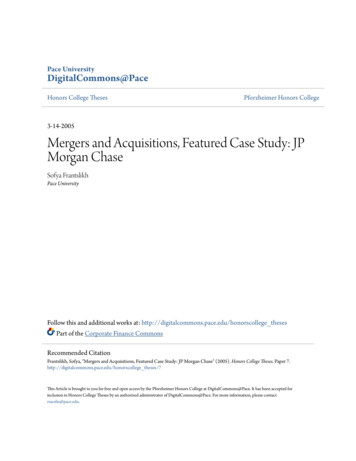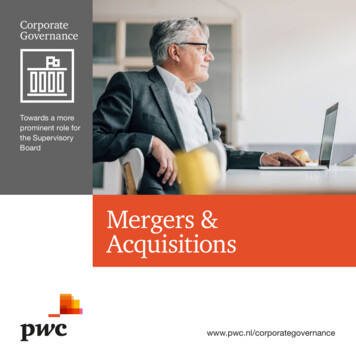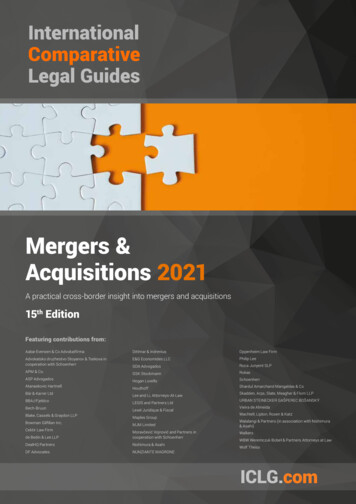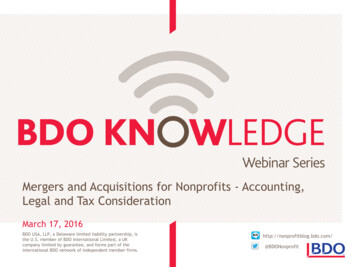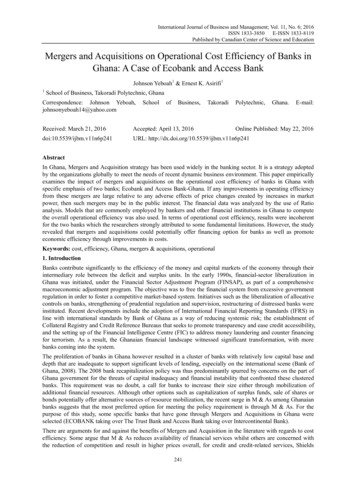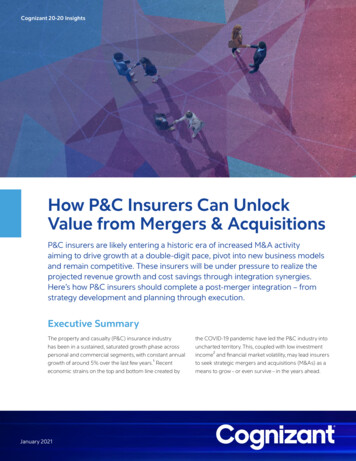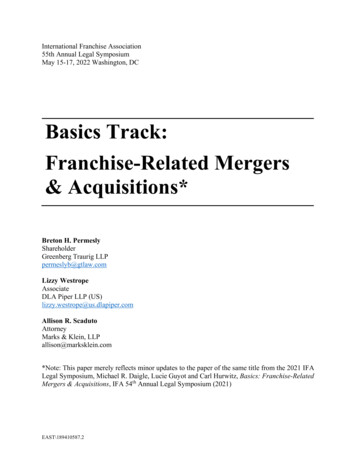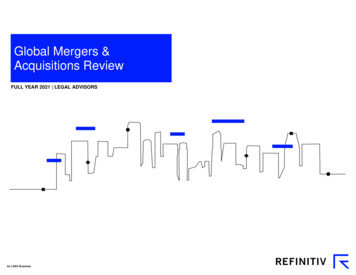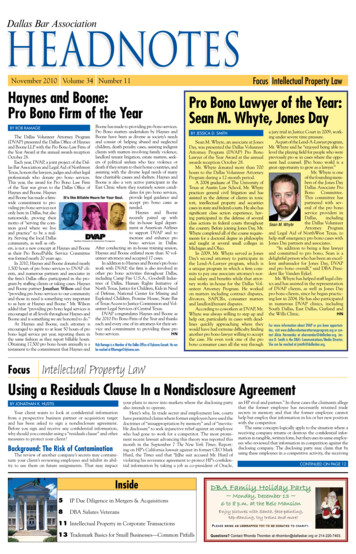
Transcription
Mergers & Acquisitionsin the RIA Industry:Overcoming the BigDisconnectbrought to you by
fainsight.comMergers & Acquisitions in the RIA Industry: Overcoming the Big DisconnectAbout the SurveyThe objective of this research was to understand the state oftoday’s M&A market within the financial advisory industry.The research was completed in December 2016 through an online survey with the owners orshareholders of 234 independent RIAs, followed by interviews and focus groups. This reportalso references data from the proprietary FA Insight M&A database (2000–present) andthe annual FA Insight Study of Advisory Firms series to draw conclusions about trends andprovide context.All survey respondents have been in operation for at least one year, generate a minimum of 100,000 in annual gross revenue and serve individuals or households as primary clients.1
fainsight.comMergers & Acquisitions in the RIA Industry: Overcoming the Big DisconnectExecutive SummaryThis time it’s real. For well over a decade now, the independent financial advisoryindustry has been abuzz with discussion about a pending merger and acquisitionboom. Industry maturation, competitive pressures and aging founders were to be thecatalysts behind a looming wave of transactions. After a few false starts, this trendappears to have finally taken hold.Major industry deals1 reached a record high in 2015 (85), double the deal total from one year prior. The 2016 deal totalcame in at 77.2 While 2016 is slightly off from 2015, it was the second-highest total over the 16 years in which FA Insighthas collected data on advisory firm merger and acquisition transactions.1 in 3 firms have been involved in a transaction withinthe last five years.3Not surprisingly, seeking a succession solution is a key motivator for 30% of firms presently considering a transaction.3While transactions are often discussed in the context of an exit path for owners, doing a deal can be equally importantfor owners interested in fostering continued growth of their firms. Tapping new markets, expanding firm expertise, andrealizing economies of scale are just a few of the growth-inducing advantages that a transaction might achieve.The share of firms with recent transaction experienceis up 31% from 2014 to 2016.41“Major deals” are defined as publicly announced deals involving the acquisition or merger of an independent advisory firm. Included is any RIA or independent trust company,serving households or individual clients, that manages at least 50 million in AUM or generates at least 500,000 in annual revenue.2FA Insight M&A Database, 2016.3The FA Insight Securing Your Firm’s Future Through Mergers and Acquisitions Survey, December 2016.4The 2016 FA Insight Study of Advisory Firms: Growth by Design.2
fainsight.comMergers & Acquisitions in the RIA Industry: Overcoming the Big Disconnect3RIAs lead the pack. Unlike in years past, the bulk of transaction activity is now initiated by RIAs. At the turn of thecentury, banks were the leading entity type initiating transactions with RIAs. Soon after, “investor multi-dealers” gainedprominence. These typically private equity-backed buyers, often referred to as aggregators or consolidators, seek torealize efficiencies or establish national brands through multiple acquisitions.Share of All Major Deals29%50%RIA Initiated Deals(2000–2009)RIA Initiated Deals(2010–2016)Source: FA Insight M&A Database, 2016.The years following the recession saw the emergence of RIAs initiating deals with each other. From 2010 on, half of all majordeals were RIA firms transacting with other RIAs. This compares to the 29% share that deals of this type accounted forduring the 2000–2009 period.RIA firms of all sizes are continuing to gain transaction experience. One reason cited by advisors is that a criticalingredient for any successful transaction is compatibility, from both a culture and business model perspective, whichmakes it more attractive for RIA sellers to partner with RIA buyers.5 In addition, given the varied methods of financingoptions available, today’s deals do not necessarily require a large amount of upfront capital, which has stimulatedsmaller firms to enter the arena.Top target: Solo advisors. At the close of 2016, 33% of firms indicated that their most recent transaction involved “acquiringa solo advisor with own practice.” When asked what best describes the type of transaction advisors were considering in thenear future, 61% selected “acquire a solo advisor.”633% of transactions cited by survey participants at the closeof 2016 involved the acquisition of a solo advisor.7FA Insight Merger and Acquisition Focus Groups, February 2017.FA Insight Securing Your Firm’s Future Through Mergers and Acquisitions Survey, 2016.7Ibid.56
fainsight.comMergers & Acquisitions in the RIA Industry: Overcoming the Big DisconnectPursuing a Successful TransactionWhen properly executed, a transaction can be transformative.Experienced buyers cite that the most successful dealsare ones that are pursued with strategic intent. Strategicintent limits the temptation to reactively respond to the nextpassing opportunity regardless of fit.Transactions work best when partners are complementary.Both parties need to assess the other to determine if theyare the best partner suited to helping them achieve theirobjectives in pursuing the transaction. If there is strategicalignment, the next item to assess is cultural fit. The mostsuccessful deals happen between parties that genuinelytrust and like each other. Coming to terms can tax even thebest relationships. If you don’t have a solid foundation towork from, you may have difficulty getting to the finish line.Successful execution of a deal doesn’t end at contractsigning, however. Those experienced in transactionsrecognize the importance of preparing for how the partieswill integrate when the deal is closed. A smooth transitionrequires a detailed implementation plan that in most caseswill require the full cooperation from both transactingparties for a period of time. Communications, directedtoward staff as well as clients, will be a priority. A timelineand prioritization of activities related to the integration ofpersonnel, client relationship servicing and operations arealso critical.Overcoming the Big DisconnectIn our interviews with advisors, we uncovered a number ofpoints throughout a merger or acquisition that can derailnegotiations or impact the ability of both parties to realizetheir expected return on investment in pursuing a deal.It behooves the buyer to take the time to share theirexperiences and rationale for the deal terms offered.An open dialogue around the terms can be helpful priorto negotiations beginning. Deal breakers may surfaceunexpectedly due to the emotional ties sellers haveto their business and personnel, which will need to beaddressed in order to move forward.Regardless of the parties involved, the best way to ensurea transaction doesn’t get derailed is to ensure that thereis compatibility, a shared vision, and open and honestcommunication throughout the process.Key Areas of Compatibility Culture Investment philosophy Client demographics Technology Shared business visionMost Popular Roadblocks Cited byAdvisors During a Transaction1Valuation methodology: Buyers and sellerscome at valuations from very differentperspectives. Both parties need to explaintheir rationale for leveraging a specificmethodology to help the other understandhow they are measuring value.2Negotiations: Only in rare scenarios doboth transacting parties agree on all terms.Entering negotiations with an open mindand a sense for which items may be of moreimportance and those on which they can beopen to compromise is important.3The seller’s inability to let go: It’s onlynatural that a seller has an emotional tie toa firm that may represent their life’s work.However, in deciding to transact, there mustalso be an acknowledgment that thingswill need to change and evolve as a dealprogresses and ultimately closes.Source: FA Insight Mergers and Acquisitions Focus Groups, February 2017.4
fainsight.comMergers & Acquisitions in the RIA Industry: Overcoming the Big DisconnectTable of Contents2Executive Summary18Valuations6M&A Activity Is on the Rise18The Great Divide6Historical Comparisons18Popular Valuation Methodologies8The End of the Solo Practice?19Bridging the Gap9Future Predictions20Pursuing a Transaction11Motivations to Sell, Merge or Acquire20Financing Sources11Buyers vs. Sellers22Defining and Negotiating Deal Terms12Why the Disconnect?22Considerations During Deal Term Definition13Anticipated vs. Actual Benefits of a RecentMerger or Acquisition23Knowing When to Walk Away14Deal Types23Words of Wisdom from Advisors WhoHave Been There14Opportunistic vs. Strategic Intent24Transition Success Factors15Typical Deal Types24Buyer/Seller or Partner Alignment15Advantages and Disadvantages of PopularDeal Types24A Collaborative Transition16Identifying the Right Partner25Summary16The Courting Phase17Assessing Compatibility5
fainsight.comMergers & Acquisitions in the RIA Industry: Overcoming the Big Disconnect6M&A Activity Is on the RiseHistorical ComparisonsTransaction activity appears to have finally caught upwith long-held forecasts. Until recently deals previouslypeaked in 2007, spurred by a healthy security market,private equity investors and the introduction of industry“aggregators.” Activity then slowed dramatically with theonset of the Great Recession.Figure 1: A nnual Transactions AnnouncementsAnnualNow deal-making has reached a new level of intensitythat may be here to stay. The level of deal-making wasunprecedented in recent years. As shown in Figure 1, nearlyas many major deals were announced in the last two yearsthan the previous four years combined.Transactions Announcements9085807769Number of Transactions702000–2014 Average 42 0122013201420152016Source: FA Insight M&A Database, 2016.“Major deals” are defined as publicly announced dealsinvolving the acquisition or merger of an independentadvisory firm. Included is any RIA or independent trustcompany, serving households or individual clients, thatmanages at least 50 million in AUM or generates at least 500,000 in annual revenue.
fainsight.comMergers & Acquisitions in the RIA Industry: Overcoming the Big Disconnect7Key drivers. One driver of increased transaction flow is a steadily aging base of firm owners looking to cash out firmequity as retirement nears. As of 2016 nearly half (46%) of owners were 55 or older. The economic climate is alsostimulating transactions. Profit margins for the typical firm, hitting a low of just 11% in 2009, have routinely been 20% ormore in recent years, spurring increasing levels of investment capital to flow into the industry. Further working in favorof heightened deal-making is an expanding number of seasoned and sophisticated RIA buyers who look to acquisitionsas an integral part of their growth strategies.Transaction Drivers8AverageAdvisor Age8EconomicClimateInvestmentCapital AccessIncreasingSophisticationof RIAsFA Insight Securing Your Firm’s Future Through Mergers and Acquisitions Survey, December 2016, and the Annual FA Insight Study of Advisory Firms Series.
fainsight.comMergers & Acquisitions in the RIA Industry: Overcoming the Big Disconnect8The End of the Solo Practice?Top target: Solo advisors. Thirty-three percent of firms indicated that their most recent transaction involved “acquiring asolo advisor with own practice.” When asked what best describes the type of transaction advisors were considering in thenear future, 61% selected “acquire a solo advisor.”933% of transactions over the last 5 years have involvedsolo advisors.10This deal type not only represents relatively low risk for an acquirer as it most likely will not include the need for personneltransfer or technology integration efforts, but also resonates with the current structure and opportunities within the industry. Ahigh volume of small owner/operators will continue to be challenged to create scale and will seek deal partners to addressboth growth and succession needs.The End of the Solo Practice?This begs the question: Are we seeing the end of the solo practice? All indications are that the advisory industrywill continue to attract entrepreneurs and provide low barriers to entry.However, as firms look to aggressively grow, are burdened with increased compliance requirements andchallenged to create scale, the trend toward consolidation will continue to provide an attractive option to those nolonger wanting to go it alone.9FA Insight Securing Your Firm’s Future Through Mergers and Acquisitions Survey, December 2016.Ibid.10
fainsight.comMergers & Acquisitions in the RIA Industry: Overcoming the Big Disconnect9Future PredictionsTransaction volume expected to keep on rising. Across all firms, exposure to, and interest in, transactions is on therise. In just two years, the number of RIAs with experience in a recent transaction grew significantly. Based on currentexpectations, the percentage of firms transacting is slated to grow much further still with 76% of firms citing that theyare expecting to take part in a transaction in the future.Figure 2: T ransaction Experience and ExpectationsPercentage of Firms ienced a transaction as of 2014Experienced a transaction as of 2016Expecting a future transaction as of 2016Sources: The FA Insight Securing Your Firm’s Future Through Mergers and Acquisitions Survey, December 2016, and The 2014 FA Insight Study of Advisory Firms: Growth by Design.
fainsight.comMergers & Acquisitions in the RIA Industry: Overcoming the Big Disconnect10Bigger RIAs are currently generating the most activity, but smaller RIAs expect the biggest jump in dealvolume. Digging deeper into the 76% of firms who indicated they are expecting to transact in the future, Figure 3shows the comparison between actual transactions completed and future expectations. While the largest firms havehistorically generated more of the deal volume, advisors expect this trend to shift. Of those planning future transactions,the smaller firms will likely experience the largest increase in activity versus large firms. This does not take into dealsize into consideration.Figure 3: T ransaction Experience and Expectations by Firm SizeTransaction Experience and ExpectationsTransaction Experience120%Expecting Transaction100%Percentage of Firms 2%14% 150K– 500K 500K– 1.5M 1.5M– 4M 4M– 8M 8M Firm Size Range by Annual RevenueSources: The FA Insight Securing Your Firm’s Future Through Mergers and Acquisitions Survey, December 2016, and The 2014 FA Insight Study of Advisory Firms: Growth by Design.
fainsight.comMergers & Acquisitions in the RIA Industry: Overcoming the Big Disconnect11Motivations to Sell, Merge or AcquireBuyers vs. SellersWhile there are a number of shared motivations between buyers and sellers to strike a deal, they approach the transactionprocess from very different perspectives. Buyers are looking to source a strategic partnership or acquisition opportunity tohelp them achieve their strategic objectives. Sellers are looking to do the same whether it be for succession purposesor pursue more aggressive growth. However, the difference is that they often have an emotional attachment to the firmthat they have built, the staff who has been loyal and clients they have developed strong relationships with over time.Motivations to Strike a Deal Increase revenue growth Acquire new clients Realize economies of scale Expand into a new market Increase asset growth Acquire talent Secure a succession plan Expand service capabilitiesBuyerEconomicsRiskStrategic alignmentCultural fitSellerEconomicsRiskStrategic alignmentCultural fitEgoEmotional ties
fainsight.comMergers & Acquisitions in the RIA Industry: Overcoming the Big Disconnect12Why the Disconnect?Given the different perspectives buyers and sellers approach a transaction from, there are numerous points along the waywhere a deal can fall through.Deals that fail most often do so during negotiating deal terms around valuation methodology, formal legal contracts and whatmay be perceived as the seller’s inability to “let go.”Seller Perspective“Anyone can say the right things, but will they actuallydo the right thing for the clients once the transaction hasbeen completed?”—Tom Rabaut, TFG Advisors“What we do is so intimate, it’s such a close relationship,it’s almost wrong to talk about buying and selling theserelationships.”—Ryon Byer, Hemington Wealth ManagementBuyer Perspective“A seller will kill a deal for an emotional reason over aneconomic reason.”—Paul Dedora, Dedora Capital“Sometimes you need to get the lawyers out of the way,which can generate friction over legal language. In mostcases, I’ve found you can work it out, if you can just havea conversation with the seller individually.”—Rob Taylor, Taylor & Morgan Asset Management
fainsight.comMergers & Acquisitions in the RIA Industry: Overcoming the Big Disconnect13Anticipated vs. Actual Benefits of a Recent Merger or AcquisitionDeals sometimes fall short of expectations. Why? Wesought to understand from advisors who have completeda deal why the transaction objectives are not fully realized.For many an increase in asset growth is realized in theshort term, while other objectives take longer to realizesuch as economies of scale. In our interviews withadvisors, we learned that as with everything, there is a bitof a learning curve.reason cited is that the complexity of the transaction canoften prolong integration efforts, specifically if there isa need to convert technology or a different approach ininvestment philosophy.There is a perception that a merger or acquisition is theeasier and most efficient path to growth versus pursuingit organically. However, even with careful planning, anagreed-upon transition period and full collaboration fromtransacting parties, unexpected obstacles may surface thatcan impact and in extreme cases derail a firm’s ability toachieve their strategic objectives. Advisors need to expectthe unforeseen and determine how to best move forwardgiven the information available.For first-time buyers, the time to realize the full benefitsof a transaction may take longer just given that they havenever acquired and integrated a firm before. The rampup time after the first deal decreases significantly as thebuyer implements lessons learned and looks to completesubsequent transactions more efficiently. A secondFigure 4: A nticipated Anticipatedvs. Actual Benefitsa Recent Mergeror Acquisitionvs.of ActualBenefitsof a RecentMerger or Acquisition58%Increase revenue growth33%Realize economies of scaleIncrease asset growth26%Provide shareholders with a succession solutionActual Benefit69%Anticipated Benefit45%45%44%32%24%27%24%24%23%23%Expand into a new marketIncrease client growthGain access to new services or expertiseImprove the client experience11%18%8%7%6%4%Gain capital for reinvesting into the firmOther0%10%20%30%40%50%60%Percentage of Firms RespondingSource: The 2016 FA Insight Study of Advisory Firms: Growth by Design.70%80%
fainsight.comMergers & Acquisitions in the RIA Industry: Overcoming the Big Disconnect14Deal TypesOpportunistic vs. Strategic IntentKnow what you are looking for and stay the course. While increasing, deal volume is relatively low in terms ofabsolute numbers, which may indicate there is more demand than supply. Given that, buyers may be tempted topursue a deal that appears opportunistically whether or not it fits the profile they are looking for. Advisors interviewedfor this research indicated that their most successful transactions were pursued with strategic intent, meaning thatthey met pre-defined criteria and were suited to helping the firm achieve their strategic objectives.Transactions by TypeFigure 5: M ost Recent Transactions by Type33%Acquired solo advisor with own practice19%Acquired firm with multiple advisors15%Acquired a book of business only13%Merged with another firm4%Acquired by some other entityAcquired by another firm1%“Tucked in” a breakaway broker1%15%Other0%5%10%15%20%25%Percentage of Firms RespondingSource: FA Insight Securing Your Firm’s Future Through Mergers and Acquisitions Survey, December 2016.30%35%
fainsight.comMergers & Acquisitions in the RIA Industry: Overcoming the Big Disconnect15Typical Deal TypesYour strategic rationale for pursuing a transaction will influence the type of transaction you ultimately engage in. The threemost popular deal types include the acquisition of a solo advisor with a practice, a multi-professional firm and a bookonly (not a firm). The following table outlines the advantages and disadvantages to be considered when determiningwhich deal type to pursue.Advantages and Disadvantages of Popular Deal TypesAcquire a Solo Advisor with a PracticeAdvantagesDisadvantages Creates additional scale while minimizing complexity of a largerintegration Proactive effort required to ensure the successful transition ofrelationships from solo advisor Provides the acquired firm a potential succession solution The role of the acquired advisor in the firm post acquisitionneeds to be clear Gaining access to new skills or markets Creates greater certainty for clients and personnel of acquiredsolo businessAcquire a Multi-Professional FirmAdvantagesDisadvantages Create scale in a more aggressive manner relative to otheroptions Integration may be more complex; planning is critical tosuccess Deepen advice expertise via the new entity to serve morecomplex clients Transition to new process and procedures, technology, teamstructure and compensation plan Benefit from “best of breed” practices across both entities tosupport growth and economies of scale Proactive effort required to retain key personnel Expand the pool of internal successors enhancing successionoptions Integrating culturesAcquire a Book Only—Not a FirmAdvantagesDisadvantages More simplistic acquisition relative to other types Client quality risk (compliance, data quality, new opportunities) Avoids integration of people and operations Proactive effort required to ensure the successful transition ofrelationships Bolsters assets and client numbers for firms that havestruggled with organic growth Fills capacity where a firm’s revenue generators areunderutilized
fainsight.comMergers & Acquisitions in the RIA Industry: Overcoming the Big Disconnect16Identifying the Right PartnerThe Courting PhaseWho is your ideal transacting partner? Similar to how you might go about creating an ideal client profile to help focusbusiness development efforts or an ideal candidate profile for a role you would like to hire, you need to determine whatyour ideal transacting partner looks like. What key attributes must they and their business possess in order to help youachieve your strategic objectives?Defining your criteria is the easy part. Many advisors find it more challenging to identify partner prospects that meet all oftheir “must haves” including some of those softer attributes.“I’m starting to wonder how many toads I need to kissbefore I find the right partner.”—Tom Rabaut, TFG AdvisorsThe courting phase is your opportunity to get to know a prospective partner not only from a business perspective but alsoa personal perspective. Can you trust them? Do they have a similar value set to you? Do you genuinely enjoy working withthem? When you identify a prospect that meets your criteria and whom you feel you can trust and work with, you have astrong foundation on which to build. Be patient: More seasoned transactors state that the “courting” phase can take up toa year or more in some cases. The more time you have to get to know a prospective partner, the better chance you haveat assessing your true compatibility.“Like the seller if you can’t go on the road with them,have a glass of wine, eat dinner together, etc., you can’tmake it work.”—John Heilner, WT Wealth Management
fainsight.comMergers & Acquisitions in the RIA Industry: Overcoming the Big Disconnect17Assessing CompatibilityWhile establishing trust and a good rapport with a prospective partner is critical before moving forward to the more technicalaspects of a transaction, wining and dining may not be enough to provide you with a true perspective. How will you know ifyou are truly working with an ideal partner or simply someone who is able to make a great first impression?The following points are thoughts on assessing compatibility from interviewed advisors:Assessing CompatibilityCompatibility AreaQuestions to ConsiderFirm culture and values What are the requirements for firm culture and business philosophy? What key stakeholder values and personality characteristics are preferred?Stakeholder role in the new firm What is the firm’s position on requiring the partner’s key stakeholders to remain withthe firm? Is there a preference for stakeholders to stay (or leave) following the transaction’s close?Vision for growth What is the prospect’s appetite for growth and preference for achieving it? How closely must the prospective partner share the same vision for growing a firm?Management style How should the ideal partner view management? Hands on or hands off? Informal orstructured? Preference for centralized or delegated authority?Investment philosophy How closely must the prospect align in terms of strategies, portfolios, products, researchreliance and outsourcing preferences?Client profile What characteristics of the prospect’s clients are required in terms of service demands,affluence, age, location or other demographics?Service approach What is the client service approach, particularly in terms of how the firm best providesvalue for target clients?Operational compatibility To what extent must the partner share similar procedures, platforms, systems andtechnology?Personnel What makes a prospect optimal in terms of personnel skill set and capabilities? Considerexperience, expertise, commitment and initiative. Will existing personnel have a place in the new firm over the short and long term?Receptivity to change How accommodating will the firm be for a partner that appears inflexible or unwilling tochange? How important is it for the prospect to be open to new ideas? Are there attributes or business areas where the firm would be more willing to accept lessflexibility from the prospective partner?
fainsight.comMergers & Acquisitions in the RIA Industry: Overcoming the Big DisconnectValuationsThe Great DivideThere are a number of inputs that go into the valuation of a firm, and depending on the strategic objectives of bothtransacting parties, the prioritization of value drivers will vary. However, there are a number of popular methodologiesleveraged by survey respondents including rule-of-thumb, income and market-based approaches.2/3 of firms reported “a fair degree of confidence” regardingtheir firm’s worth.11Most firms believe they have a good feel for their valuation. Two-thirds of surveyed firms reported “a fair degree ofconfidence” regarding the worth of their firm.12 The challenge seems to be in getting the other side to agree with theirvaluation assessment. Why the disconnect? Often the disconnect arises due to a lack of transaction experience forone or both of the transacting parties who may be relying on a rule-of-thumb or word-of-mouth approach to valuation.Popular Valuation Methodologies1112MethodologyPercentageof SurveyRespondentsLeveragingDescriptionRule of Thumb65%Typically based on a multiple of revenue, earnings or assets under management. It doesnot take into consideration key drivers of a firm’s value such as expected future cashflow, risk, client demographics and growth potential.Income60%Based on calculating the net present value of future cash flows, with the applied discountrate based on the risk associated with the firm’s ability to meet growth projections.Market35%Utilizes sales data from comparable transactions. Given the deal volume within theRIA industry, firms may be challenged to find sufficient comparable transaction data toleverage this method effectively.FA Insight Securing Your Firm’s Future Through Mergers and Acquisitions Survey, December 2016.Ibid.18
fainsight.comMergers & Acquisitions in the RIA Industry: Overcoming the Big DisconnectFigure 6: Valuation Assistance Relied UponValuationAssistance Relied Upon47%Internal analysis30%Word-of-mouth28%Industry specialist27%Modeling tool10%Generalist .0%35.0%40.0%45.0%50.0%Percentage of Firms RespondingSource: FA Insight Securing Your Firm’s Future Through Mergers and Acquisitions Survey, December 2016.In addition, there may be an emotional attachment that maybe hampering the ability to approach a valuation exerciseobjectively or too much emphasis placed on a valuationderived with the assistance of a third party. Valuations are anecessary component of pursuing a transaction; however,they are often just a starting point for negotiation.Third-party valuation assistance. Regarding leveragingthird-party assistance, just 28% of survey participantsindicated that they have worked with an industry specialistand another 10% report use of a generalist consultant.13Interviewed advisors often relied on valuation specialists forassistance with their transactions, particularly with biggertransactions. They largely agreed that outside expertise washelpful in validating estimates and smoothing negotiations witha few caveats. Occasionally a deal participant may fixate ona third-party estimate and be unwilling to compromise awayfrom this number. Additionally, certain valuation providers whoprice as well as facilitate a deal may have a
RIA Initiated Deals (2010-2016) RIA Initiated Deals (2000-2009) The years following the recession saw the emergence of RIAs initiating deals with each other. From 2010 on, half of all major deals were RIA firms transacting with other RIAs. This compares to the 29% share that deals of this type accounted for during the 2000-2009 period.


